Rebranding is a transformative process that can redefine the essence of a company. It requires both creative vision and strategic thinking, with the aim of aligning a brand's identity with its evolved mission, values, or market position.
A company may choose to rebrand for a number of reasons - from shedding an outdated image to reflecting a change in customer - and they are likely more common than you would think. We ran a recent survey which uncovered that 82% of marketers have worked on a rebranding project before.
Rebranding your businesses is no easy feat, but it can be pivotal to your company’s success. In fact, 74% of the S&P 100 companies have rebranded within their first seven years of operation according to Landor.
In this guide, we have broken down everything you need to know about rebranding, including important statistics and expert advice.
What is a rebrand?
Rebranding is a strategic process where a business changes its corporate image, typically to establish a new identity in the minds of consumers, investors, prospects, and other stakeholders.
It can reflect societal, socio-cultural, competitive and geopolitical changes, as well as consumer sentiment and trends. The rebranding process will likely include changing the name, logo, visual identity, mission, or the entire brand architecture of the company.
Why do businesses rebrand?
A company may choose to rebrand for a number of reasons, all of which must be driven by clear and compelling reasons that justify the investment of time and resources.
In one of our recent surveys, we found that the most common reason for rebranding, as identified by 57% of marketers, is to update brand identity.
Other significant reasons to implement a rebranding strategy include repositioning the brand in the market (45%), reflecting a change in target audience (41%), and addressing negative brand perceptions (26%).
Of course, there are countless additional reasons to rebrand, but the common theme amongst all motivations is to reflect a different message through branding.
How to rebrand a company
A rebrand will look different for every company, based on the size of the organisation, the motivation behind the project, the resources available, amongst countless other factors.
However the process of how to rebrand a company, typically, can be summarised in five main steps.
1. Define your aims and reasons for rebranding
Define your aims for the rebrand - what message are you trying to convey?
2. Develop your rebrand strategy
Formulate a rebrand strategy including key milestones, designated responsibilities, and set a timeline for the rollout.
3. Create new brand guidelines
Create brand guidelines, including a visual identity to reflect the new branding, and any other relevant specifications such as tone of voice guidelines. All of these definitions should be compiled into a comprehensive brand style guide.
4. Source feedback
Before rolling out the rebrand, gather feedback from select audiences and make final adjustments to the new brand guidelines.
5. Implement the rebrand
Transform marketing assets across the business, updating branding across all channels, from your website and social media to packaging and advertising.
6. Launch your rebrand
Consider dates, market readiness and the news cycle before finally launching your rebrand.
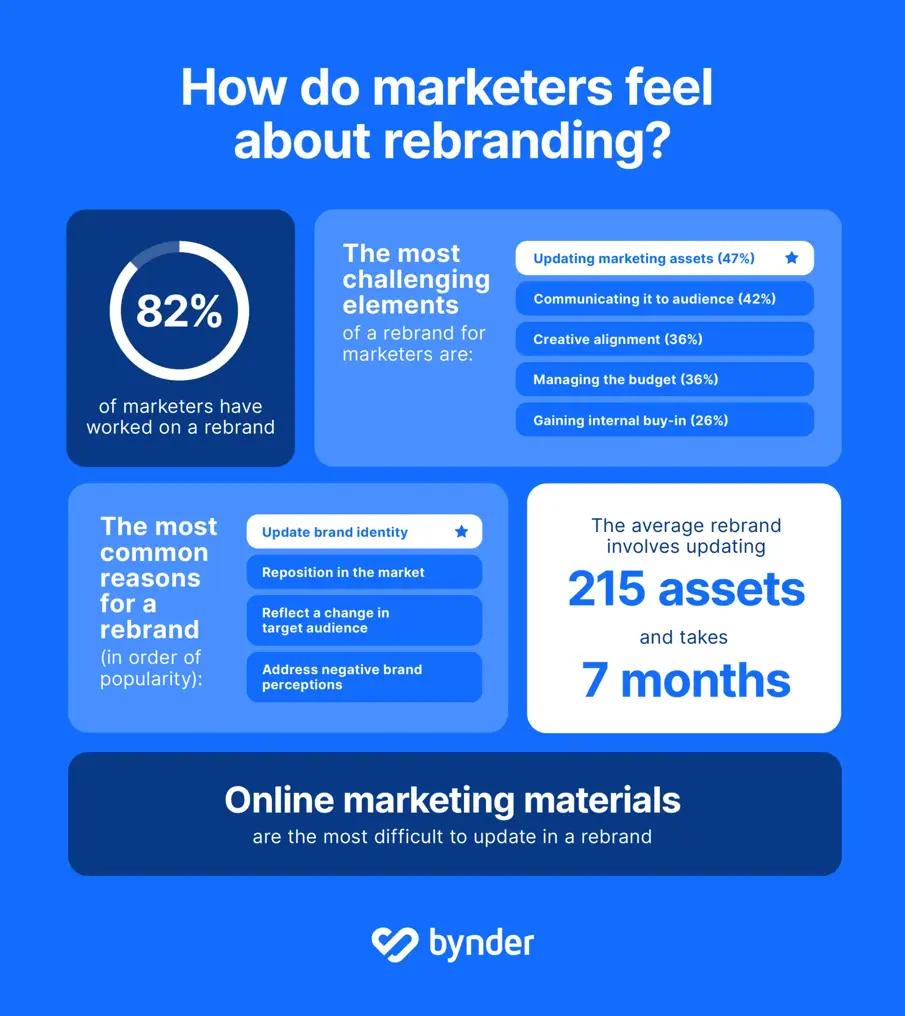
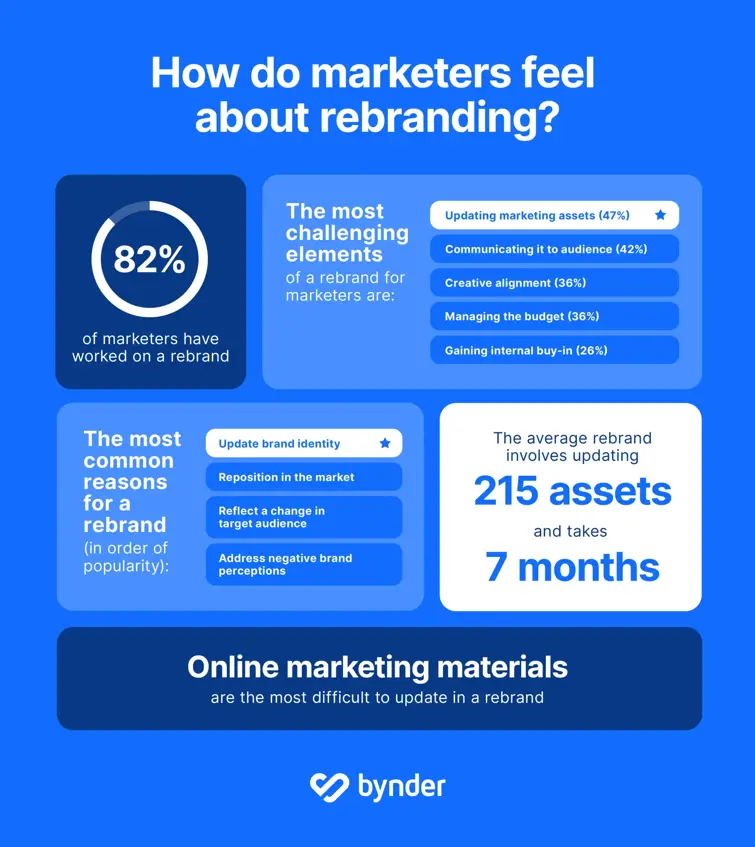
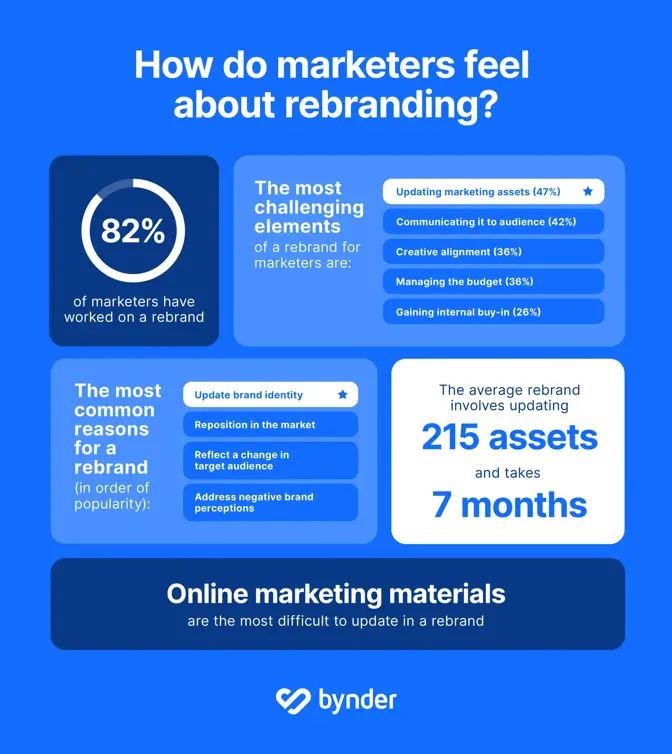
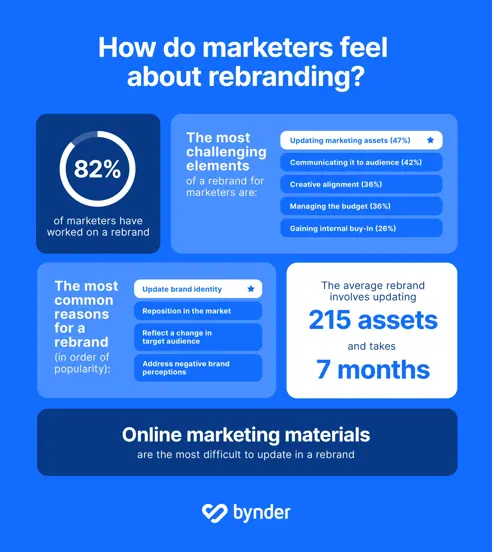
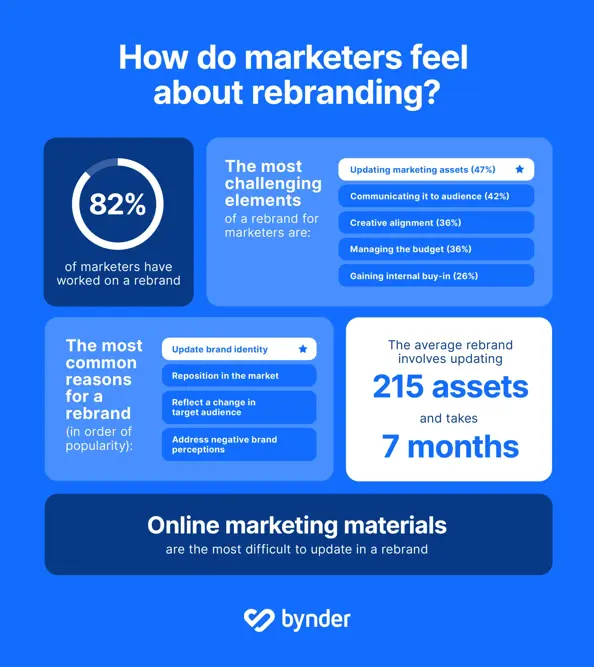
How long does a rebrand take?
Our data suggests that the average rebrand takes seven months in total, from initial talks to rollout.
This finding was sourced through a survey of 1,002 marketers that we conducted Bynder in 2023, however the length of a rebrand will of course depend on a number of factors, including the company size and the number of assets which require rebranding.
In fact, the survey data found that almost one in ten marketers have worked on a rebrand which lasted between one and two years.
With regards to frequency, Custom Logo Shop reported that businesses tend to rebrand every seven to ten years, with smaller branding refreshes in the interim.
How many assets need updating in a rebrand?
On average, 215 assets will be required to be updated in a typical rebrand, based on our recent survey data.
The huge number of assets which require transformation could likely explain why a typical rebrand takes seven months in total. What’s more, marketers reported that updating marketing assets is the most difficult part of a rebrand according to our survey data.
There are many different kinds of assets which will likely need to be updated during a businesses’ rebrand, including:
- Company logo
- Packaging
- Merchandise
- Email templates
- Internal documents such as presentation slides
- Social media assets
Interestingly, online marketing materials were found to be the most difficult to update in a rebrand; followed by printed materials and then ecommerce sites.
Why is rebranding important?
Rebranding can be crucial to a company’s success, which is demonstrated by a number of studies on the impact of good branding.
One report from Lucidpress suggests that brand consistency can increase revenue by 10-20%, and Millward Brown conducted a study to find that strong brands have three times the sales volume of weak brands.
In 2024, the consumer is more informed than ever, and the market is likely more saturated with competitors with exciting and different branding. It’s no surprise that 45% of customers expect great design across marketing and sales collateral as reported by Lucidpress. A survey run by VistaPrint also found that 60% of consumers avoid companies with weird or unappealing logo designs, even if they have good reviews.
What is involved in a seasonal rebrand?
A seasonal rebrand describes the act of temporarily updating your company’s branding for a certain season - one of the most common of which being Christmas.
We surveyed 600 professionals in the marketing industry, to find that 17 types of marketing assets (such as digital logos, packaging, physical ads) are typically rebranded for Christmas.
Christmas rebrands are understandably less time and resource consuming than a typical rebrand, taking on average 5.7 months.
Marketers reported that they rebrand content for nine different holidays on average, such as Black Friday, Halloween and New Year’s Day.
What are the most common challenges of a rebrand?
We quizzed marketers on the most challenging elements of a rebrand, which were found to be:
- Updating marketing assets (47%)
- Communicating the rebrand to our audience (42%)
- Creative alignment (36%)
- Managing the budget (36%)
- Gaining internal buy in (26%)
Rebrands can also be met with negative reactions from consumers which can feel disheartening to marketing teams. However, responses should be tracked over time, as initial reactions may be a response to the change rather than the new branding itself.
What are some of the most talked-about rebrands?
Our team investigated the most Googled rebrands in the UK, to uncover that those with the highest monthly searches are:
- ITV
- Pepsi
- Lilt
- Burberry
- Celebrations
- Hermes
- Channel 4
- BT Sport
- BBC
- Pets at Home
The most commonly searched for question regarding a rebrand is “Why did Hermes rebrand?”. Communication is crucial when it comes to rebranding, so clear outlines on the purpose of a rebrand is advisable.
How can DAM help with rebranding?
All of our research illustrates the importance of a rebranding project, but also the significance of getting it right. Rebranding more than just updating a logo, it’s making sure the new brand identity is consistently represented across all channels.
A Digital Asset Management platform can help companies with a rebrand in order to centralise marketing assets and improve efficiency in the implementation of the rebrand.
A DAM platform provides a single source of truth for all marketing assets, making it easy to identify and update the right assets.
Conclusion
Rebranding is an important part of most companies' journeys, and rightly so. Data indicates how strong branding directly impacts the revenue of a company, and rebranding reflects that your brand is moving and changing with the times.
The process takes a lot of time and resource with data suggesting that it takes on average seven months from initial talks to rollout. If your business, or the business you work for, is planning on rebranding, clear aims, comprehensive brand guidelines and a single source of truth for all content are imperative for success.












